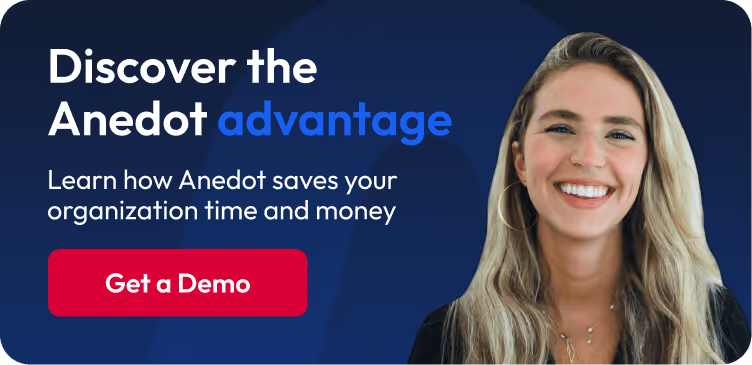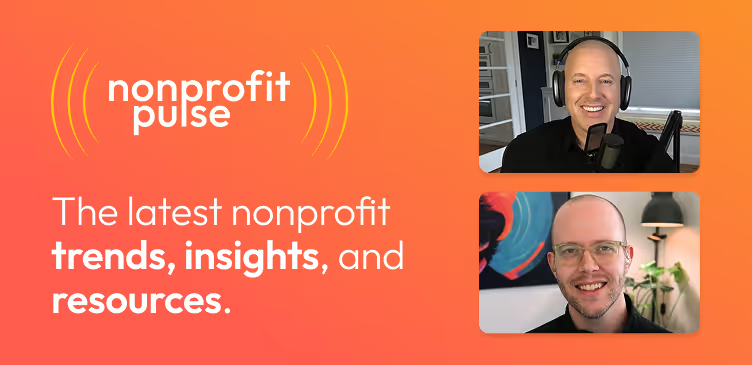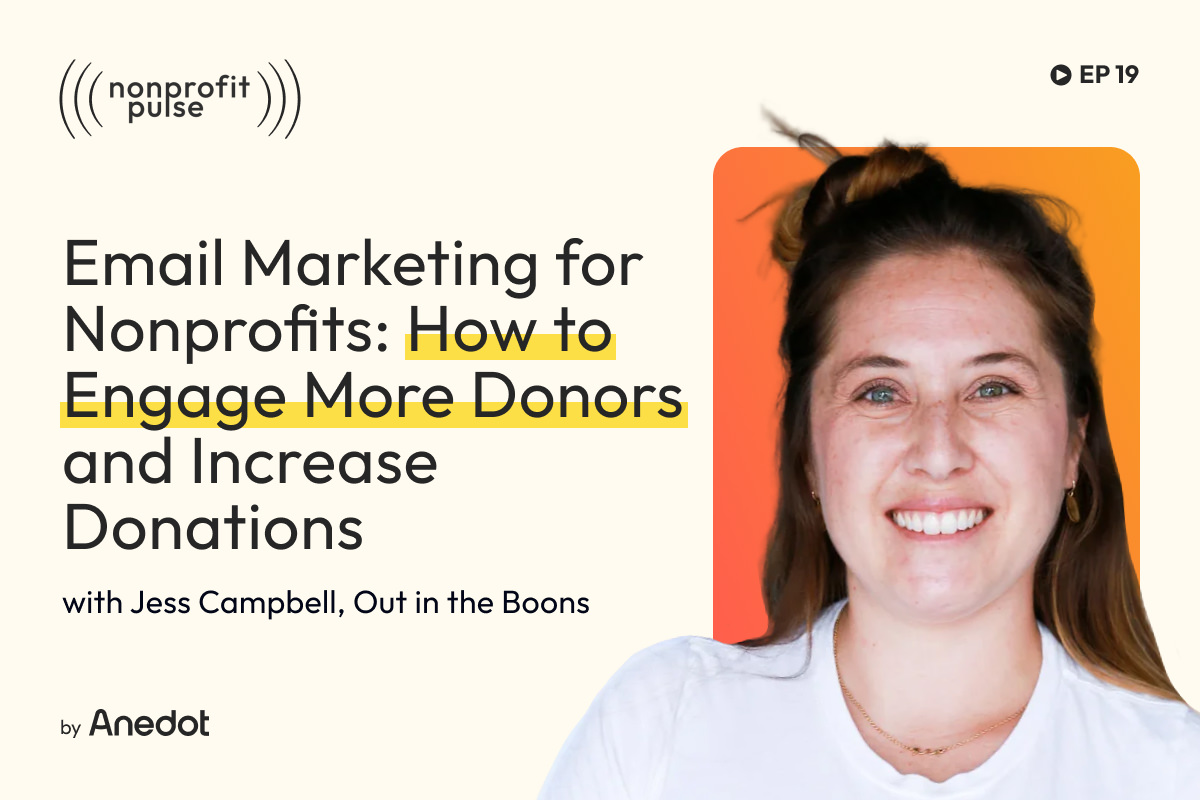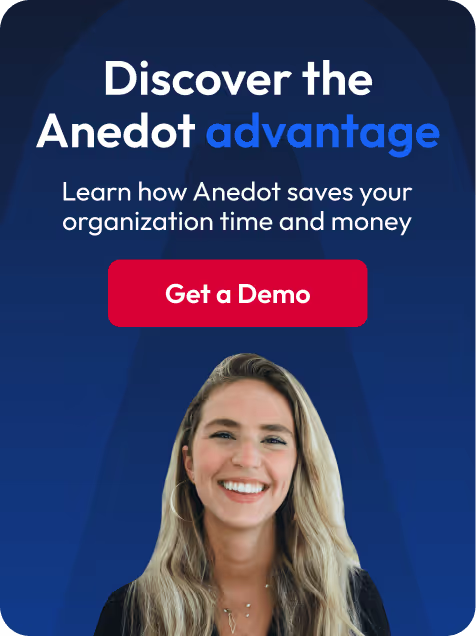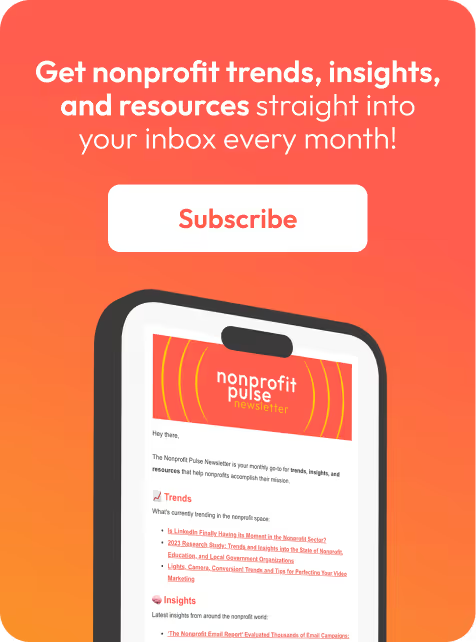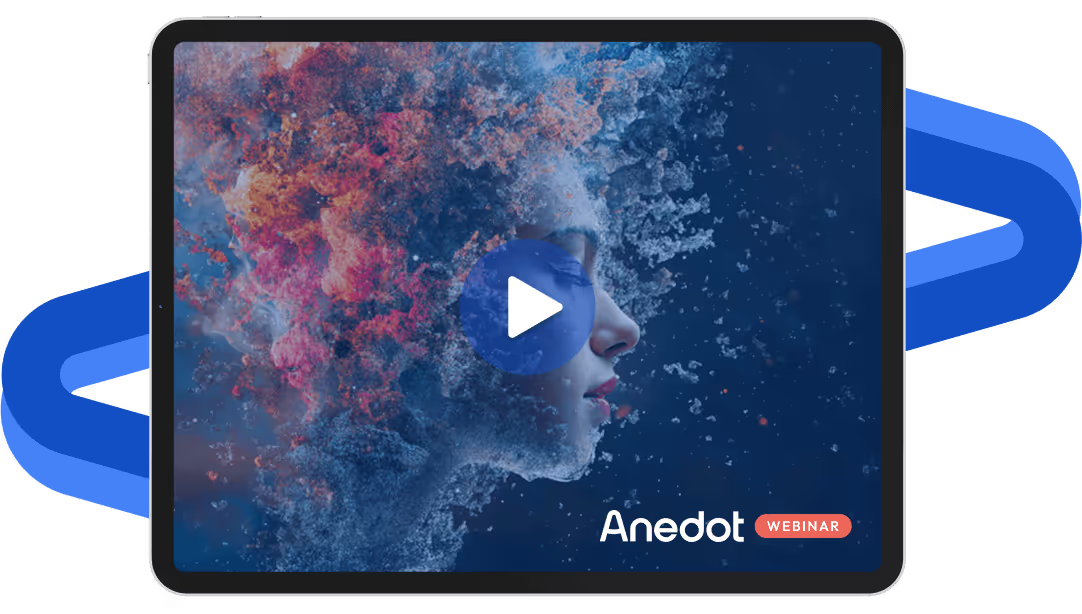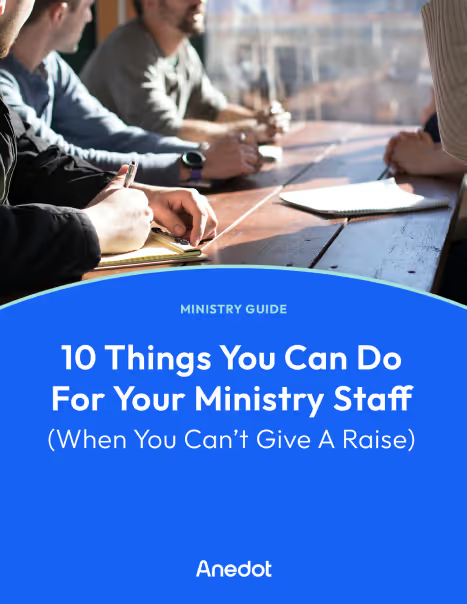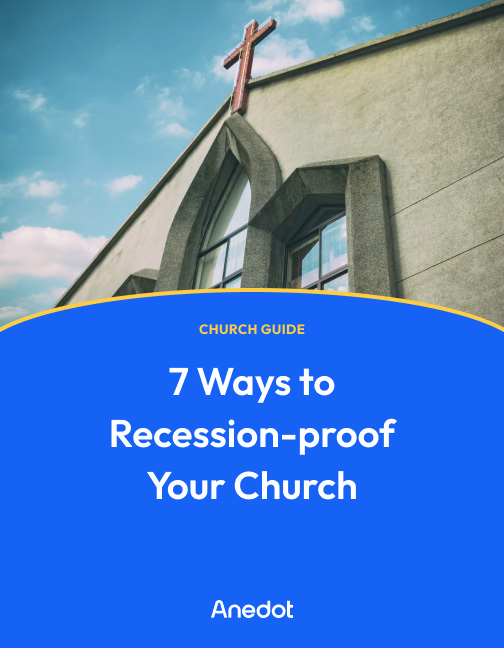Podcast episode transcript ↓
Josh:
Building an email list is not just about numbers.
It's your organization's lifeline to connecting with supporters and securing donations.
So how can your organization effectively expand its email list to enhance impact and ensure long term sustainability?
I'm Josh with Anedot and welcome to Nonprofit Pulse where we explore trends, insights, and resources that help nonprofits accomplish their mission.
On this episode, we're joined by Jess Campbell on the topic of email marketing for nonprofits.
Jess is the founder of Out in the Boons, where she helps nonprofits discover donors in their email lists. She has been a nonprofit fundraiser for 18 years and has raised over $17M+ working from New York to California in organizations big and small.
Hey, Jess, welcome to Nonprofit Pulse.
Jess:
Hi, Josh. Thanks for having me.
The importance of email marketing for nonprofits in a changing digital landscape

Josh:
I'm so excited for today's episode. We're talking about email marketing for nonprofits, which I know a lot of nonprofits struggle to grow their email list.
And then beyond growing, you know, how to maintain it, best practices, trends. We're going to get into all of that today.
So maybe first just starting out, will you share some of the current trends that you're seeing in email fundraising right now?
What new approaches or tools out there that nonprofits should be looking into?
Jess:
Well, again, thanks for having me talk about my favorite topic on the planet.
I think that email is having a real moment. So as far as a trend goes, I mean, I wouldn't call email a trend because it's just everlasting.
But I feel like with the constant updates to our social platforms, Instagram being down every other day, Twitter getting a new name.
Like even LinkedIn, which has been a very powerful tool for me, you know, some days you hit it and some days you get little to no engagement, where email consistently remains to be the most powerful marketing tool that I use in my business as well as I deploy for my clients.
And so as far as trends go, I'm like just be emailing, like prioritize email. That is more than a trend. That should be like a lifestyle.
Josh:
I love that. Yeah. And speaking of lists and list building, engagement, you know, nonprofit email list is huge for many reasons.
One of which you just mentioned, platform performance. It's kind of hit or miss.
You may struggle on certain channels, but with your email list, you own that list.
You're not constrained by any of the algorithm updates of Google for organic search or any of the platforms. All of the For You pages across the platforms.
But with your email list, you have the opportunity to reach out at any time you want, say anything you need to say, and measure that and understand what the relationship is between you and your audience in a much deeper way.
Effective strategies to grow your nonprofit's email list and boost engagement

Josh:
So let's talk about growing the list. Do you have any advice on how not to only grow the list, but also keeping your audience engaged?
You know, that means open rates. That means, you know, click throughs, open rates, but also clicking through your resources or your links, as well as any follow up.
So that was a lot of things in one. So yeah, just growing your list and increasing engagement. What would you say?
Jess:
Yeah. So I would say that for everyone listening, there's a lot of pressure I feel out there from whether it's leadership teams, boards, or just our external competition to have this really big list.
100,000, like these massive lists, right?
And I always say, I would rather have an engaged list over a large list every day of the week.
And that takes work, that takes a lot of consistency, a lot of providing value. And we can talk about content in a bit.
1. Prioritize getting your first 1,000 email subscribers
I would just say that if you're just starting with email marketing, I would prioritize getting your first 1,000 subscribers so that you can really test and have proper data to make strategic decisions.
It's difficult to do that with less than 1,000 people.
So I would first say, do what you can to get to a thousand and we can talk about some ways to grow your list.
2. Scrub your email list 2-4 times a year
But then as far as donor engagement goes, that's an ongoing process where, I recommend scrubbing your list.
I know nonprofits in general work so hard to acquire names and emails and donors and all the things.
And so the idea of actively removing those people can feel quite scary.
But the thing is, if you're sending consistent, valuable emails on a regular basis and people haven't opened anything from you in 12, 18, 24 months, the likelihood that they are going to is unlikely.
And frankly, they're just bringing down all of your data and making you make ill informed data decisions. Right? Because you have this kind of stale list.
That actually happened with a ton of my clients at the end of the 2023 giving season. I ran probably around, I think it was eight end of year campaigns. Email was a big part of it.
I was like, why is this such a slog? This is like we all made it, but it was painful to get to the finish line for across everyone.
So I was thinking what was different this year?
And I think what happened is a lot of these organizations made huge acquisitions of donors and email subscribers in 2020 and 2021, maybe even a little of 2022, but they maybe did or did not put in the work to retain these folks or keep them engaged.
And so what they have now is this larger list, but with unengaged people.
So while we were basing our data decisions and making math decisions based on our numbers, they were actually incorrect because we were working with stale lists.
I would say the first step, and I recommend doing it anywhere from 2 to 4 times a year, is scrub your list.
I'm a bit more, radical. I do it, like if you haven't opened any of my emails from 90, 120 days, I put you through a sequence and I invite you to stay. But I also wish you well if you wanna go.
That might be a bit too aggressive for a nonprofit.
I would say if you’re a nonprofit, anywhere between 12 and 24 months and no one's opened your email, you too should put them through a 3 or 4 part sequence to try and get them engaged.
And if not, then you can say, you know, farewell and goodbye.
They can always come back. So that's what I’d say about engagement.
3. Present valuable resources in exchange for emails
As far as list building goes, I joke all the time that, you know, I have like a master's degree,
I've spent a lot of money on my brain, and the two hardest things I've ever done are teach my kid how to poop in the potty and grow an email list.
Like it is hard. And it's only getting more difficult because the user, the subscriber, is more savvy than ever.
You know, back in 2020, people were giving out their email to download a freebie or whatever left, right, and center.
And now people are way more cautious.
So you have to be really thoughtful and invite them to join in exchange for something valuable. Valuable is relative.
You have to do a little brainstorm about what that means for your potential subscriber or your subscriber.
But there's kind of a hierarchy, if you will, about list growing because, you know, some things are definitely more advanced.
And I don't expect someone that decides to get started with email marketing today to do the automations and the workflows and the Pinterest and all these complicated things on day one.
If you're really starting on day one, send out an email to 40, 50, 60 people and make your case for why your email list and your newsletter for your nonprofit is the place to be.
And what information are they going to get?
What's different in that channel that's different from your social? How often are they going to receive communication?
I like to provide my best and first content access through my email list. I reward people for being on my email list and so they get the best discounts.
They get the first, opportunity to join. They get more stories, they get more consistency. All of that is through my email list.
And then my social channels are the next tier.
So if you're all in on email, I would say just start with an invitation to your ideal subscriber for like your first 40, 50 people, right?
If you're trying to grow from your next, let's say, 100 to 1,000 subscribers and above, I think some great list building activities, things that I do, or I do for my clients is do a teaser post on, let's call it Monday.
If I send my emails on Tuesday mornings, I will preview what is to come in that email on a Monday.
So, for example, I have, this email coming out where I'm going to be teaching, don't be a good, be an effective writer because, and it's all about like throwing out everything you learned in high school English and doing what's actually effective when it comes to conversion copywriting and acquiring donors and all the things.
And so I'll probably give tip one in that post, but I'll say something like, if you want, you know, tip three, four, and five or whatever, sign up for my newsletter list and you'll get it delivered tomorrow.
And I would say on a weekly basis for me, that usually gets me anywhere from like 15 to 25 new subscribers just right there.
So if you do that every single Monday for a month, you know, that's roughly 100 new subscribers. So that's one thing you can do.
Another thing that I recommend folks doing as far as list building goes, is put something of value together that people would want to get in exchange for their email.
So one of my clients right now is the Chamber of Mothers. They are advocating for paid family leave, maternal health, and affordable childcare.
We just put together this rage Spotify playlist.
And we've been marketing it as like if you're a mom who wants to sit in the car alone, if you're a mom who really needs to go on a run, if you're a mom that feels like screaming into a pillow, like put on this rage playlist and jam out.
That's kind of like the vibe of what we're doing.
And it's simple. It's like 50 songs. It's on Spotify, which is free. It's super duper easy. But to get the playlists, you have to give us your email.
And that allows us to do two things acquire new email subscribers, but also segment those people on the back end.
So we know, okay, these are the type of people we know where they came from, what they're interested in, all these things.
And so that's another way to go from anywhere from hundreds if not thousands of people. So, a freebie.
→ Looking for more ways to grow your email list? Here are 7 ways on how to build an email list!
4. Partner and collaborate with other organizations
And then the last thing I'll suggest, which is a bit more advanced, is to partner and collaborate.
So let's say, for example, you're in the animal welfare space and you're a dog rescue. Can you partner up with 2 or 3 other animal rescues who you each probably have your little niche or specialty, right?
And let's say in my dog rescue, I can put a tutorial on how to teach your rescue dog how to walk on a leash.
But the other dog rescue can put a recipe together on how to make your food from scratch. And then the other dog rescue can teach you how to sit, shake, and rollover or something.
I don't know, whatever people who, I have a rescue dog, so I'm like, all of these things would be interesting to me.
But what if y’all partnered and bundled together, and then you all share that with your individual list, and then you all shared the email list that came together. It's kind of like that spider web effect, right?
All of your subscribers across all three lists are getting something super valuable, and you are also attracting your ideal donor audience.
One thing I get pushback on quite a bit is like, but Jess, if we're going to partner up with two other dog rescues, isn't that our competition? Like, aren't they going to go donate to these other ones instead of us?
And I really challenge anyone who's thinking that way to really work on their money mindset, their scarcity mindset.
Because personally, the older I get, the narrower I get with my philanthropy.
So I actually almost exclusively give to organizations that are in some way, shape, or form supporting mothers, single mothers, single black mothers. I was raised by a single mom.
I am a mom. I have in some ways been on both sides of the motherhood spectrum as far as being resourced and under resourced.
And so it’s what I'm passionate about. And so I give across the board almost exclusively to organizations that do that versus me being spread out around, you know, regenerative food or, you know, like, all the things.
And so it's actually better for organizations to partner and collaborate and put in my peripheral because that's the place I want to go deeper on.
I would just say that because, like, I've gotten that a little bit before where people are like, wait, I don't want them to have my donors on their email list or whatever.
I'm like, no, that's not the way to think about it.
Josh:
Yes. Differentiate. Don't compete.
I think a lot of nonprofits struggle to even have that conversation because of the aversion of thinking about everyone as competition, when really the opportunity is to differentiate.
And whether you're a golden retriever rescue or you’re another type of a cat rescue or only a certain type of cats or, you know, etc., lean into that differentiation and then people will support typically multiple of the same type of orgs, but they at least know how the impact, or what impact your nonprofit is having that is different than the other one, where they see, okay, I should support these two orgs.
This one's doing this, the other one's doing this. I care for both. And I want to support both.
The anatomy of a successful nonprofit email marketing campaign

Josh:
So let's lean into the content for fundraising emails in particular and thinking about what moves the needle when it comes to soliciting donations via email.
Are you seeing any type of content out there that's performing better?
Any type of positioning around programs or initiatives that helps to convert better?
Understanding that look, in the nonprofit world, we're not all about just conversions and draining dollars from our donors, but really casting a vision of the impact that can be achieved through these dollars.
So that said, what content are you seeing that's really moving the needle as far as, okay, I definitely want to donate to that?
Jess:
I'm going to start with what doesn't work first.
What doesn't work is you on a random Wednesday sending off some random email that asks for money. That just doesn't work.
I teach what's called a warm up phase, which is generally two, four, six weeks of preparing your donors to open, click, and reply.
We don't really want, and neither do I ever expect a donor to click for the very first time on a donate button.
Like anything, we have to build habits. And so we want our donors, our subscribers, our readers to get in the habit of not only opening, but reading and clicking off the page.
And so that requires some advanced planning.
So let's say you are an organization that helps veterans return back home, and you provide anything from like health care, to employment services, to mental health services.
Right? But you're about to run a campaign all around employment. You know, this entrepreneurship program.
I would not spend my 4 or 6 weeks leading up to this campaign talking about mental health services.
That doesn't mean that's not important, but if you're out here talking about the other two parts of your program, and then you kind of turn and you're like, but support our entrepreneurship program.
People are like, wait, what? Like, what are they?...
Versus you preparing people along the way where you're talking about veteran, you know, veteran Tim, who started his ice cream selling business versus, you know, Maria, who, you know, is a real estate agent or whatever the things are.
If you told those individual stories along the way and then you made a case for why supporting the entrepreneurship program makes sense.
People are like, oh, obviously. Oh, duh. Of course I'm going to support this.
You got to really prepare. You've got to warm people up along the way before you make an ask.
1. Personalize your email
The anatomy of an ask emails is get your pen and paper out. This is it.
It is personalization. So, hi first name, dear first name, howdy first name.
It really makes no one feel seen when you're like hey, friend. Hi, supporter.
If that's all you have, that's all you have. But, use the name.
2. Use cold opens
I also do sometimes what's called, a cold open. I've been teaching this a bit more.
I learned it from this amazing copywriter named Ann Handley. She's not who invented it, but she's who brought it to my attention.
And it's what they do for, like, Saturday Night Live and a lot of sitcoms. It's basically when they just drop you in.
So instead of it being like, hey, how are you? So on last Tuesday, I was like, and you're just like, blah blah, blah, blah, blah, blah, blah.
This is a cold open. I actually recently wrote it in an email. My opening line was, it's 2AM and there's poop everywhere.
It's like, boom, you just drop someone in and someone's like, what? And like, I got to read more.
So doing a cold open in any kind of email, whether it's an ask or not, is really powerful.
And I really challenge organizations to just like plop people in, get right to the meat.
3. Tell powerful and long stories
The other thing I'll say is stories are really powerful, long stories.
I think people are like, oh, I can't write a long email. It can't be too this or too that. It's actually like, no, those again and again have been tested.
There's a resource called NextAfter, they do experiments constantly.
Constantly, they show that long form email works, but it needs to be singular.
So one story, about one thing, with one call to action.
We're not putting in our emails. But also you can volunteer and also share this email. And also we've got this event.
It's like, no, if you want people to donate, make your email about donating.
4. Include multiple links in your email
You also need several links.
Neon One is a CRM platform. They put out a really great report on email marketing for nonprofits in 2023, and they assessed out of millions of sends, how many links work best.
I think the number is six.
So it's hyperlinked, it's in buttons, it's in P.S. sentences. It's many, many, many links throughout, but they all go to the same place.
So I would say those are kind of the biggies for an ask email.
5. Write curiosity sparking subject lines
Gotta get opens though. So you want to have a really kind of, curiosity sparking, I would even use the word sexy subject line.
My friend Jamyle Cannon, he runs an organization called The Bloc in Chicago. It's this boxing program, afterschool boxing program.
He had the best appeal. You know, like, I have it in a saved folder. I send it out everywhere. I did not write it, but his subject line was, he almost quit.
And you're like, well, who's he? And what did he almost quit? It's like, I have to open this email to find out, right?
Then his email was simple. There was no images. It was a story with a red donate button and other links.
I don't even know if he had a P.S. sentence. I would always recommend a P.S. sentence, but it was really strong.
So if you're an organization that thinks it's a lot of work to build an email because of all the images and the graphics, I'm telling you now to scrap them.
They do not work as effectively as a text based storytelling single call to action email and, keep it clean.
6. Let your words breathe
Forget what you learned in your high school English class, as far as following paragraphs.
You want your words to breathe. So you want to leave spaces.
You don't want anything too thick, and you have to remember people are reading on their phones a lot of time.
So if they’re often doing this like heavy thumb scroll to get to the point, you're going to miss an opportunity to get people to actually make the donation.
7. Send a lot more emails
The last thing I'll say about appeals, before we move on maybe, is you need to send probably double, if not triple, the amount of emails you think you need to send.
So I have so many organizations that come to me and they're like, we're going to send, you know, it's the end of the year and they want to send like 2 or 3 emails and like, you need to send 2 or 3 emails on the last day, more emails.
And for anyone who's really worried about overwhelming their list you can do two things.
You can stop looking at your unsubscribes and stop caring about what everyone else is thinking because we're trying to be effective, not people pleasing.
So there's a mentality thing right? But I also actually really, respect and respond to people who do permission based fundraising.
And so it's totally appropriate.
And okay, if you want to include a link that says, like, not interested in this campaign right now, click right here and you can remove them from this segment and people can actively opt out.
The other thing is, once someone makes a donation, you need to stop asking them for money.
So you need to remove them from your kind of massive main list.
And they need to get a different set of emails because nothing makes the donor feel unseen as them making a gift to your organization and then they get that next Giving Tuesday email or whatever.
Send your emails now and focus on email segmentation later

Josh:
Yeah. Can you share more on how many lists, generally speaking, a nonprofit should be maintaining and building?
From those who are outside of the donor relationship, to those who are, to long time supporters.
I mean, there's many ways to go about it, but what do you coach your clients on as far as segmenting out lists and building those?
Jess:
Yeah, I think that this can be a very slippery slope.
So I think that maybe this is a little hot take, but if this segmentation part is what's holding you back from emailing your list, stop sweating the segmentation. It's more important for you to send the email.
That being said, the savvier and the more advanced you get, I think having segments related to donors versus non donors, or lapsed donors versus current donors, or recurring donors versus one time gifts, or volunteers and board members.
I mean, that's what I mean. Like, you can go hog wild with segmentation.
And if the perfectionism of not having that in place is what's holding you back, just send an email to everyone, like it's fine.
As far as what you say to people, you know, like I think it is important to be mindful.
So if you just ran a campaign and you're trying to send a gratitude email, are you sending that to your entire list or are you just sending that to the people that made a gift, right?
I think you should just send it to the people that made a gift versus, here's what was achieved, kind of congratulatory that like, everyone can be involved in.
That being said, I wouldn't let anyone be held back around segmentation because 100% of the nonprofits that come to me are not sending enough emails, period.
Josh:
So it's more about getting out there, doing it, growing your list.
Once you have, once you start to see some complexity around your audience, then discuss segmenting, build out your strategy of how you're going to segment and grow each of these different lists.
Jess:
Yeah, I mean, it's always going to be easier to do it from the get go. Right?
So if you have a system that allows you to segment or tag or whatever they call it, like identifying those people early on is going to be way easier than like retroactive work.
But I'm just saying that like if it's the difference of you not sending the email because you can't say, hey, current donor, versus hey, lapsed donor.
Just send the one email. You know what I mean? Done is better than perfect, I would say in this situation.
Helpful nonprofit email marketing metrics to track

Josh:
So I want to talk about measuring success and what that looks like as far as metrics.
What metrics do you advise your clients to watch, to monitor, and then also how can they use those for insights to better inform their email strategy overall?
Jess:
Okay. So a couple of things that I pay attention to.
There is the measurement of open rate. But it's dicey, especially since the iOS update of 2021. It's basically like a false number.
So while you are going to look at it, it's not the be all end all.
1. Click through rates and reply rates
What in my opinion is a way more important metric to follow is your click through rate as well as your reply rate, which is people actually hitting reply and answering the question you prompt them to answer.
People actually don't know this, but your email deliverability is like a muscle and it takes time to build strength.
So if you are showing up in spam boxes or people are marking you as spam, you're going to get dinged.
Where if people are replying to your emails, you're going to get stronger.
And so I don't do it in every email, but occasionally in a client's email, I'll say something like, choose A, B, C, or D. Hit reply and let me know with your answer.
Or I'll say, I'll ask kind of a question and I'll ask people to reply and that will prompt people to actually do that.
2. Email list growth rate
Some other things that I think people should pay attention to are their email list growth rate.
How many people are coming to your list week over week over week? One, because I can sense that it feels like a slow and steady race.
And it's one of those things that if you keep track of and you look week to week, it doesn't feel that big, but you look back months later and you're like, oh my gosh, we actually have like 300 new people on our list. Cool.
Can we do something for these people? Like it provides a conversation.
3. Unsubscribed rates
Other things that I would pay attention to are or excuse me, that I would not pay attention to deeply is your unsubscribed rate.
That being said, if you have an anomaly like you have a week where like, it's just ten times higher than average, that actually could be a really good thing.
For example, for me and my list, there's been moments where I have talked about women's rights or I have talked about values that are important to me, and not everyone agrees.
And guess what? I think it's amazing that they self unsubscribe from my list because they're not who I want there anyways.
I actually think that nonprofits in general could do a much better job of having an opinion on things, and they're afraid to do that because they're afraid to push people away.
But actually, what it's really going to do is attract people, the right people first.
It might clear off a good number of people that you don't want there anyways, and it will attract the right people from the get go.
So I would say those are the top measurements.
4. Conversion rates
Some other measurements that you can look at are your conversion rates.
If it's a fundraising email, how many people are clicking and then what resulted in an actual donation?
Because you might have to do some tweaking to your donation page.
For example, if people are clicking, but somewhere along the donation process, they're dropping off, that's an important thing to look at as well.
Nonprofit email marketing success stories

Josh:
Love that. And kind of moving out of the theory or the practical side and moving into a real example.
Could you share an example of a nonprofit that you've worked with that's just had remarkable results from email marketing, email fundraising efforts?
And you know, what strategies did they use to really win in that email campaign?
Jess:
Yes, I mean, right now, I'll just go back to Chamber of Mothers.
So they’re a young organization, they're like less than three years old and they have a massive social following. Massive, like thousands and thousands of people.
And their email list comparatively is quite small. And, you know, they're all volunteers. They're this amazing group of very smart and talented women, but they have no background in fundraising.
And so they just started where they started, which was mostly on Instagram. And while they've gotten a lot of awareness, you know, awareness doesn't pay the expenses of running a nonprofit and the ultimate goal is to bring on staff members.
And so through bringing me on, we've been growing their list, which is amazing. But we've, in the last 12 months, ran both a Mother's Day campaign and an end of year campaign.
And I think one of the things that has been so illuminating for them is how literally every time we send an email, we get donations, period.
And it's just nothing that you can compare on social. And they've been able to meet their goals. And what's really cool is, two things.
One, people use email like a to do list. Where I describe social as kind of like a freeway. Cars are just driving by and maybe they get off here or maybe they get off there.
But email, I mean, think about how you use your email.
I use my personal, whether we're supposed to or not, I do, and so I save my action items for that.
And so if I don't get triggers in my email, it's probably not getting done. And so sending more emails, even when it feels uncomfortable, has been a really powerful tool for them.
But what's also been really cool that's happened during their end of year giving campaign is major gift donors actually would present themselves.
And they were like, you know, I started seeing you in my inbox more. I started getting more communication from you.
And, you know, unfortunately on social, they were posting a lot as well.
But if only 3 to 5% of your audience sees your posts anyways, like you're likely missing it. Where in your inbox everyone's going to get it.
And so it did this really kind of cool wrap around effect of bringing in people who were kind of like, loosely aware to being now acutely aware of both the problem and the solution they could provide by providing a donation.
And so now that they've kind of seen the power of email, it's like now we're going all in.
So, we have these big goals and big strategies that involve everything from like Pinterest and driving traffic and using all sorts of different acquisition tools that it's just been really cool to see in a short period of time how your organization can raise hundreds of thousands of dollars through email.
Josh:
Yeah, and it makes sense, right? If you think about how we consume social media versus how we relate to our inbox.
I can't think of a time recently where I saw a product on my Twitter or Facebook or LinkedIn feed and clicked on it and bought it.
But I can think of many times where I was on a list for a certain type of product or a brand.
And I saw it and said, take my money, let's do this. And I love that language of action items. That really is what email is for so many folks.
If they're subscribed to your list, there's a relationship there. They are receiving value.
They want to know what you have to say, whether that's impact reports, whether that's here's new things we're doing, or even here's current needs. Right?
They want to know what's going on and being able to communicate those things, in a real human way, that helps them in some way.
And again, it doesn't have to be helping them in a transactional way.
It can just be keeping them updated on this thing that happened last quarter that there wasn't an update on and say, hey, we thought you might want to know if you remember last quarter this happened, it was a disaster or it was a real challenge.
But now we've got the funding or now we've got the leader to handle that, the volunteer to handle that.
Those things, are like water in an oasis to people's inboxes where they've got all sorts of spam, solicitations.
Those things are so real and human and bring people into your story in just such a significant way.
Jess:
Yeah. I mean, one thing, I love everything you said, like, double tap, underscore, circle with a red pen.
Two things I want to say, just like to follow up, is one thing that I tell my students quite a lot is you are not your subscriber.
And because I get people saying like, well, if I send a lot of emails, I'm going to come across as spammy and like my inboxes overflow.
I don't want one more email. And the thing that I want to say is everything that I teach is based on data.
So if the data said that social or events or any of these other things were super effective, I would probably be teaching you to do those things.
But it doesn’t. It says that emails work.
I really want people to step back and follow the data versus like follow your feelings because you are not your subscriber and maybe you don't like a full inbox, but you probably still get that email from Target every day.
Are you unsubscribing from that?
And the truth is, is whether you like it or not, that's what users are comparing you to as far as familiarity.
I used to joke before they went bankrupt. Rest in peace, Bed Bath and Beyond.
But like I used to get multiple emails from them every single day because who knows, maybe, maybe one day I would like actually walk into a store and use their 20% off coupon, like never ever happened.
But maybe. Did I ever unsubscribe from those emails? Not once.
And so when they ran a sale or whatever and they're sending me six emails a day, I just didn't open them. I wasn't like unsubscribing.
And so if you're only sending one email a month and now it's time for you to ask for money and you're sending like ten emails in a month, people are going to be like, wait, who is this?
Like, why are they showing up in my inbox? And why are they asking me for money? Unsubscribe.
Versus them being really familiar. The other thing I just want to say real quick, I think email fundraising can absolutely, 100%, without a doubt, replace event fundraising.
And I know from experience how much time and how much money all you nonprofits listening spend producing events. And the net profits of those events are sometimes minimal.
And if you have the ability to put a really strategic, thoughtful campaign that you send through email and maybe like a hard copy piece of mail or something, and you can raise the same amount of money, it's like, why are we doing this to ourselves?
Why? Why are we putting ourselves through that event fundraising cycle if we can just like run a campaign?
So there's a lot of opportunity, for everyone.
Josh:
Well, especially too, if you think about the resourcing of that event and what you could do over two years of taking those two years of event funds, and applied it to a new email strategy, new email resource.
Whether it's a part time worker, whether that's a fractional, or they hire you Jess., Just taking that, you know, using NextAfter’s language, right?
Those experiments. Let's experiment. You know, we've done this event for 12 years in a row.
Let's back up. Let's not do it this year. And let's take those funds and lean into a sustainable email marketing, email fundraising campaign. Let’s just see what happens.
Jess:
Yeah, absolutely. 100%. I will die on that hill.
Closing thoughts

Josh:
Awesome, awesome. So getting towards the end here, Jess, any fundraising resources that you would recommend to our audience?
Jess:
Okay, a couple fundraising resources, especially when it comes to email. I mentioned NextAfter.
I really do feel like their library of experiments is like candy to me. I geek out on it. If you geek out on that kind of thing, that's a great resource.
The Neon One email report is also really helpful.
And then I would be remiss if I didn't mention my own things.
So, Out in the Boons. We actually have two really helpful tools for folks who are interested in email marketing.
If you go to Thefundraisingtemplateshop.com, we actually have fill in the blank templates and templates sets where you can get a nine part spring campaign, fill in the blanks, schedule and send, easy peasy lemon squeezy.
We also have a fundraising template membership. So for $11 a month, you get a Monday drop every single week, which features a new type of email for your organization.
Some weeks it's like a podcast pitching email. We did an Earth Day template recently.
We are doing pre-campaign launch email. We do campaigns and appeals and upgrades and asks for monthly donors.
We do all sorts of things. So that's $11 a month. It's less than $3 a template. It's kind of a no brainer. And you can find that at Thefundraisingtemplateshop.com.
And for anyone who’s just maybe thinking about what's missing from my nonprofit? Like, how can I improve it?
If you go to Outintheboons.me/quiz, we've got this 90 second quiz that's pretty fun to take.
Josh:
Awesome. And as always, you can find those resources listed in the show notes for this episode.
And now for our last question, Jess. My favorite question of every episode, where our guests have to be pithy and provide clarity after we've unpacked all these things.
If you were standing on stage in front of a thousand nonprofit leaders, what is one sentence, one thing you would say to them about email marketing, email fundraising?
Jess:
Send more emails. Period.
Josh:
Love it, love it. This is a huge topic with so much to explore and we've really just kind of scratched the surface and dived a little bit here and there.
But, check out the show notes for all those resources Jess mentioned.
And Jess, thanks so much for coming on the podcast and sharing today.
Jess:
Thanks for having me.
Josh:
Hey, thanks for listening.
If you enjoyed this conversation, please share or leave us a rating and review wherever you listen to podcasts.
Also, head on over to Nonprofitpulse.com to sign up for our monthly newsletter, as well as check out all the links and resources in the show notes. We’ll see you next time.
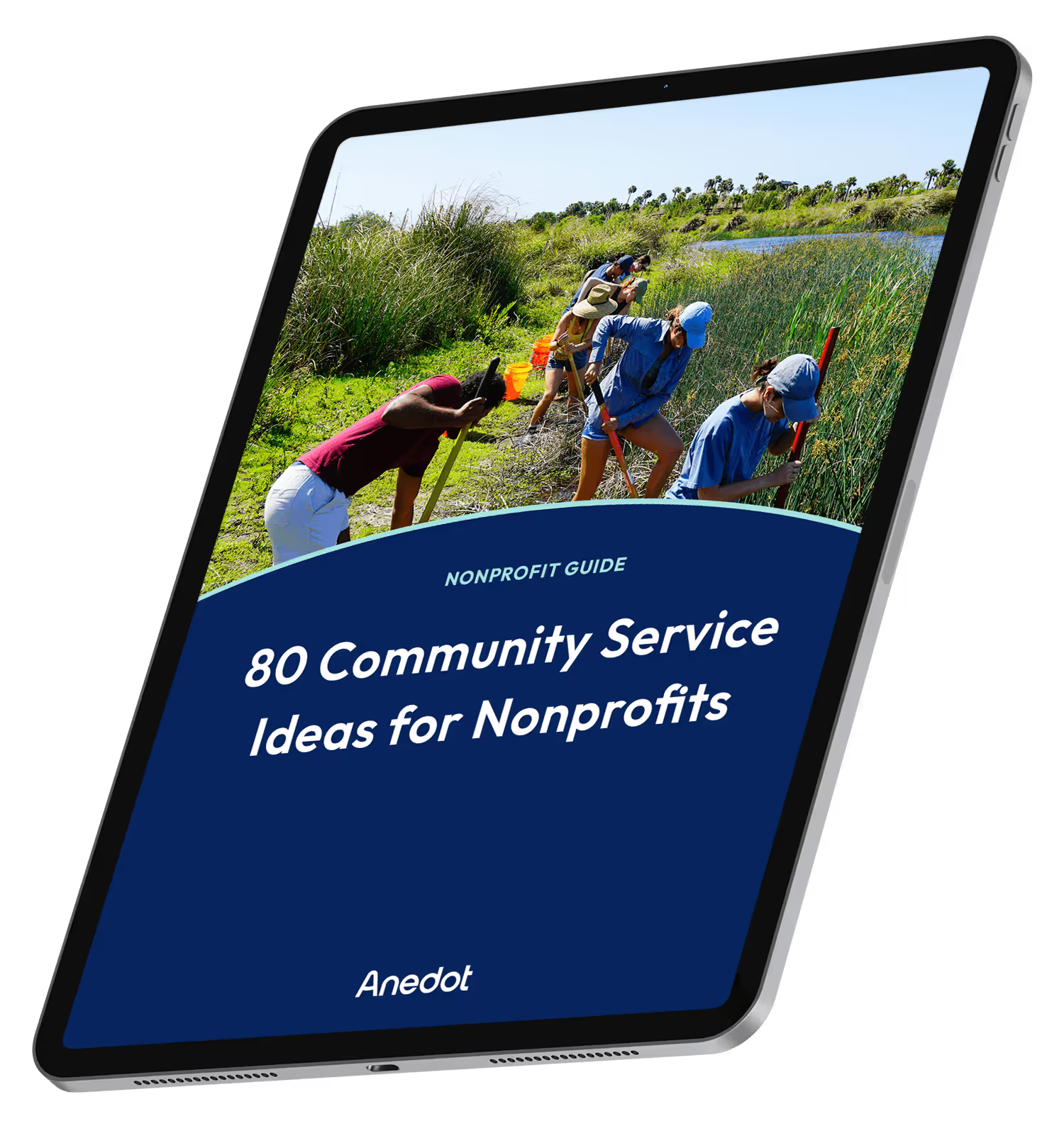
80 Community Service Ideas for Nonprofits
